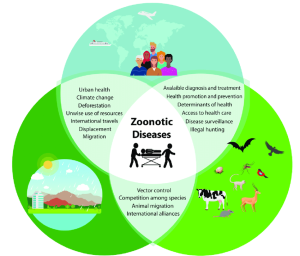75 One Health Approach

Influenzas and Zoonoses Education among Youth in Agriculture Program is an initiative led by the Centers for Disease Control and Prevention (CDC) to educate young individuals involved in agriculture about zoonotic diseases (Centers for Disease Control and Prevention 2023). The program was launched in 2011 in response to influenza outbreaks associated with pigs and works with groups such as the U.S. Department of Agriculture (USDA) and the Council of State and Territorial Epidemiologists (CSTE) to implement a One Health approach that brings together efforts in human, animal and environmental health (Centers for Disease Control and Prevention 2023). Objectives of the program include increasing knowledge on how zoonoses spread and what it takes to stop them. It encourages participating in behaviors that minimize the transmission of diseases and increases awareness of the roles that public and animal health sectors can play in disease prevention through collaboration. The program also seeks to develop relationships among stakeholders to better respond to public and animal health needs, and for increased awareness of careers in the field. CDC The program has grown significantly since its founding, touching the lives of hundreds of thousands of youth and their families throughout rural America. It has created interactive activities, workshops and biosecurity resources to encourage safe practices in production environments. The program is an essential part of protecting human and animal health through the national One Health network at the local state level and among agricultural communities (Centers for Disease Control and Prevention 2023). (E.B.)
A collaborative, multisectoral and transdisciplinary strategy, One Health integrates human, animal, and environmental health so people, animals, and ecosystems can balance their welfare in a sustainable manner. Acknowledging that complex relationships exist between humans, pets, livestock, plants, wild animals and the environment. It holds that the health of one depends on the health of all. It rests on new understandings about the fact that a high proportion of newly emerging and re-emerging infectious diseases are zoonotic and are transmitted between animals and people (World Health Organization 2023). These environmental changes at the human-animal-environmental interface, including deforestation, loss of biodiversity, climate change, intensive farming or animal husbandry practices, pollution, urbanization and global travel can be thought to increase opportunities for spillover events (World Health Organization 2023). (E.B.)
The One Health approach depends on working together across different sectors, including national governments, academia, industry, and civil society. This collaboration is necessary for addressing health and ecosystem threats, dilemmas of climate change, access to clean water, air, and energy, food safety and nutrition. Combining human health, animal health, and environmental concerns into a single framework. One Health advances sustainable development while also shoring up international public health emergency preparedness (Siedner et al. 2020). (E.B.)
To generate backing for this strategy, a global partnership known as the Quadripartite has been established; comprising the FAO (Food and Agriculture Organization), UNEP (United Nations Environment Programme), WHO (World Health Organization) and OIE (World Organization for Animal Health). These organizations jointly crafted the One Health Joint Plan of Action, which outlines concerted, multisectoral operations to fight health threats at the human-animal-environment interface with particular emphasis on emerging zoonotic diseases (World Health Organization 2023). (E.B.)
Acting according to One Health means understanding the driving forces behind emerging zoonotic diseases, formulating resolutions to mitigate risk, strengthening surveillance and early warning systems in case of outbreaks and so when outbreaks do happen, one is ready with an immediate response plan. By doing so, the One Health approach can prevent, predict, detect, and respond to threats in human health while maintaining the well-being of animals and plants in their environment (World Health Organization 2023). (E.B.)
The One Health control strategy has successfully worked against rabies in Bhutan, Bangladesh and Sri Lanka, where its successful implementation has been possible due to a number of key factors. Bhutan, for instance, has a low recorded incidence of rabies 17 cases between 2006 and 2016. This shows that rabies can be controlled through vaccination programs for animals, public awareness campaigns, surveillance systems, and inter-sectoral coordination to prevent rabies and ensure responsible pet ownership and timely detection. Bangladesh has emerged as a model for scalable One Health interventions through testing strategies in small rural communities before scaling them up. This method contributed to lowering rabies deaths from 1,500 in 2012 down to only 200 in 2015. In Sri Lanka, mass campaigns to vaccinate dogs have shown that an animal health approach is effective in reducing transmission of the disease to humans. All of these countries together represent the success of an integrated One Health approach based on animal health, scientific evidence, and multi-sectoral collaboration. The collaboration of these different countries highlights the importance of national and global collaboration in fighting zoonotic diseases. One Health provides a multi-sector collaborative approach essential for finding sustainable longer-term solutions to disease prevention and control (World Health Organization 2023). (E.B.)
